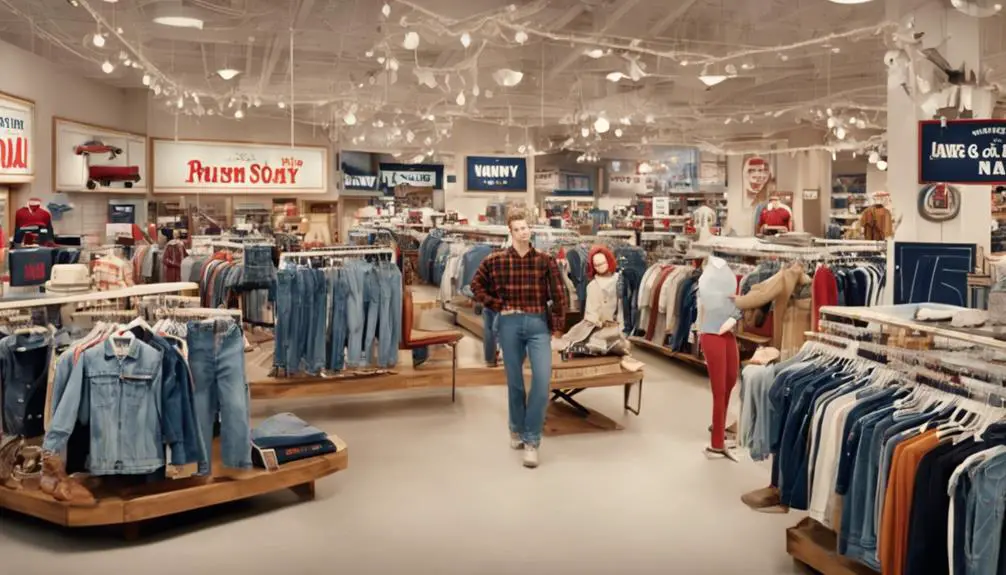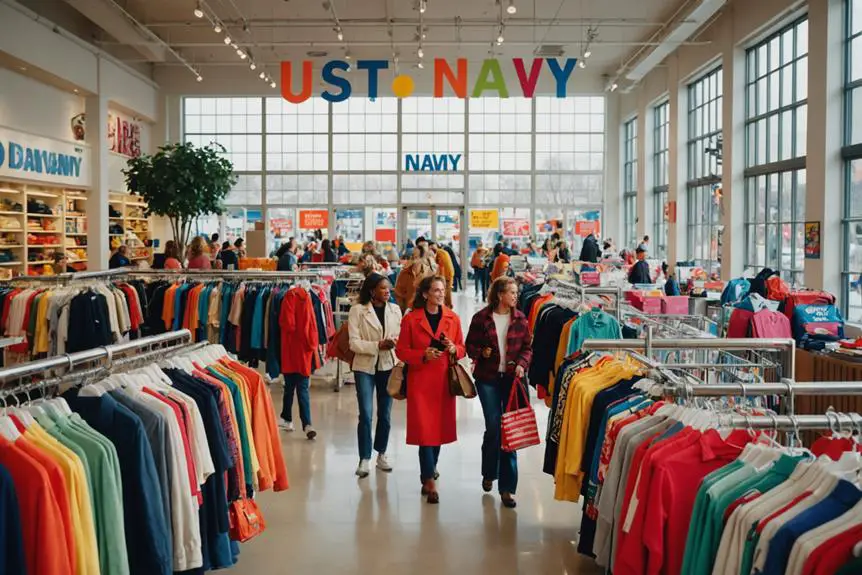Old Navy was founded in 1994 as a budget-friendly clothing retailer aimed at families. The first store opened in Colma, California, originally under the name Gap Warehouse. It rebranded to Old Navy Clothing Co. on March 11, 1994, inspired by a casual bar in Paris. Within its first year, it quickly expanded to 59 locations and made history by becoming the fastest retailer to achieve $1 billion in sales by 1997. The brand focused on providing stylish, affordable clothing, which set new trends in the fashion industry and paved the way for inclusivity. There's even more to discover about its journey!
Origins of Old Navy

Old Navy's origins trace back to 1994, when it emerged as a subsidiary of Gap Inc., designed to cater to families looking for trendy yet affordable clothing. The first Old Navy store opened in Colma, California, creating a vibrant shopping atmosphere that attracted budget-conscious families.
Initially named Gap Warehouse, the brand underwent a rebranding on March 11, 1994, taking inspiration from a Paris café to become Old Navy Clothing Co. This rebranding reflected a commitment to accessible fashion, which played a significant role in its early success and rapid expansion.
This fresh approach to fashion quickly resonated with shoppers. Old Navy focused on offering styles that appealed to everyone, from kids to parents, ensuring that the entire family could find something trendy without breaking the bank.
In just four years, Old Navy achieved a remarkable milestone, reaching an astounding $1 billion in sales, making it the fastest retailer to do so in history. This achievement was largely due to the brand's innovative strategies, such as the introduction of the BODEQUALITY Initiative, which promoted inclusive sizing without price differences.
The brand's inclusive vision and dedication to value-driven fashion positioned it as one of the largest apparel brands globally. You can see how the combination of fun, affordability, and a family-oriented shopping experience captured the hearts of many shoppers.
Old Navy's playful designs and affordable prices allowed families to dress stylishly without financial strain. This innovative spirit laid the foundation for its ongoing success in the competitive retail landscape.
As you explore Old Navy, remember that it all started with a simple idea: making fashion accessible for everyone, one family at a time.
Key Milestones in 1994
In 1994, a significant transformation in the retail landscape began with the launch of Old Navy as a budget-friendly alternative to Gap. The first store opened its doors in Colma, California, and was originally named Gap Warehouse. However, on March 11, 1994, it was rebranded as Old Navy Clothing Co., setting the stage for a new shopping experience.
The store layout mimicked a grocery store, creating a fun shopping atmosphere that appealed to families and budget-conscious shoppers alike.
Old Navy quickly gained traction in the retail world, showcasing rapid growth that was simply remarkable. By the end of 1994, the brand had expanded to 59 stores, capturing the hearts of many customers looking for affordable clothing.
This initial success wasn't just a fluke; within just four years, Old Navy would reach a staggering $1 billion in sales, making it the fastest retailer in history to hit that milestone.
The combination of a vibrant store design and budget-friendly pricing helped Old Navy stand out in a crowded market. It provided a shopping experience that felt different from traditional retailers, encouraging families to enjoy their time while finding great deals on clothing.
As you can see, 1994 marked a pivotal year for Old Navy, laying the groundwork for its future as a beloved brand in American retail. The excitement and energy of those early days still resonate today, reminding us of Old Navy's unique place in the retail landscape.
Expansion and Growth Strategy

With a clear vision for growth and a commitment to affordability, Old Navy quickly carved out a significant niche in the retail market. Opening its first store in Colma, California, in 1994, Old Navy's rapid expansion showcased a successful growth strategy. Within the first year, the brand boasted 59 stores, and by 1997, it became the first retailer to achieve $1 billion in annual sales, a remarkable feat in the retail industry.
Old Navy's expansion didn't stop at U.S. borders. In 2001, the brand ventured into the Canadian market, marking the beginning of its international expansion. Adapting to local consumer preferences allowed Old Navy to grow its footprint beyond the United States.
To cater to a broader demographic, Old Navy introduced plus sizes in 2005, enhancing its competitiveness in the market and solidifying its reputation as a family shopping destination. This move was a vital part of their growth strategy, appealing to more customers seeking affordable fashion.
Key elements of Old Navy's successful growth strategy include:
- Rapid store expansion, quickly establishing a nationwide presence.
- Introduction of plus sizes to reach a diverse customer base.
- International expansion to tap into new markets and consumer demands.
Through these strategies, Old Navy hasn't only thrived but also set itself apart as a leader in affordable family fashion, making shopping accessible and enjoyable for everyone.
Brand Evolution Over Time
As Old Navy expanded its reach and solidified its presence in the retail landscape, the brand also embraced a dynamic evolution over time. Founded in 1994 as a subsidiary of Gap, Inc., Old Navy quickly captured the market with trendy, low-cost clothing, achieving $1 billion in sales within its first four years. This rapid success set the stage for its ongoing transformation.
In 2011, Old Navy launched Project ONE, a major rebranding initiative focused on modernizing its image and enhancing customer experiences. This evolution didn't stop there. The BODEQUALITY initiative, introduced in 1996, showcased Old Navy's commitment to inclusivity by offering women's styles in sizes 0-30 at the same price point. This focus on diversity in fashion has become a hallmark of the brand.
Old Navy's marketing strategies also played an essential role in its evolution. Nostalgic advertising campaigns and celebrity collaborations helped the brand maintain cultural relevance and appeal across generations.
Furthermore, as society increasingly values sustainability, Old Navy has stepped up, integrating environmentally friendly practices into its operations. This shift reflects a broader understanding that fashion needs to be responsible, not just trendy.
Through these efforts, Old Navy has successfully navigated the complex waters of retail, showcasing an impressive brand evolution that balances sales with inclusivity, sustainability, and innovative marketing.
As you explore the brand's journey, it's clear that Old Navy is more than just a clothing retailer; it's a symbol of changing values in fashion.
Impact on Fashion Industry

Transforming the retail landscape, Old Navy has made a significant impact on the fashion industry since its inception. Founded in 1994, it was the first apparel retailer to achieve a staggering $1 billion in sales within just four years, a record that still stands today. By emphasizing affordable fashion and trendy designs, Old Navy popularized casual wear for families, shifting retail dynamics to focus on budget-friendly options.
You might be surprised to learn how Old Navy has also championed size inclusivity. With its BODEQUALITY initiative, launched in 1996, the brand offered women's styles in sizes 0-30 without price differences, setting a new standard for diversity in the industry. This commitment to inclusivity resonates with customers and encourages other retailers to follow suit.
Old Navy's innovative marketing campaigns have played a vital role in its cultural resonance. Take a look at their retro TV ads from 2002; they connected with a wide range of demographics, enhancing the brand's market presence.
Additionally, Old Navy's dedication to sustainability and environmentally friendly practices sets a precedent in retail, inspiring other brands to adopt eco-conscious methods.
In summary, Old Navy hasn't only redefined casual wear but has also influenced the fashion industry in several key ways:
- Pioneered size inclusivity standards
- Popularized affordable fashion for families
- Set sustainability benchmarks for other retailers
Through these efforts, Old Navy continues to shape a more inclusive and environmentally aware fashion landscape.




